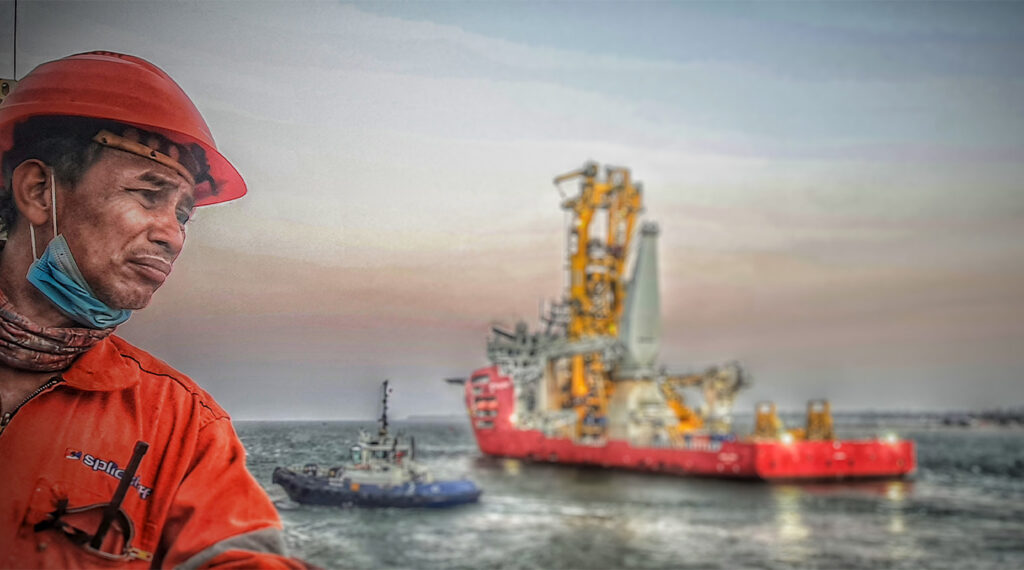All at sea: Shining a light on a hidden workforce

Globally, we all rely on the ocean to provide food, energy and the transit of goods, yet working at sea remains one of most dangerous occupations in the world. While 90% of the world’s trade and fuel moves by sea, the 1.89 million seafarers working on 50,000 merchant vessels are often invisible to the general population and are therefore ‘out of sight and out of mind’.
With ‘hidden’ workforces such as seafaring, the safety challenges can be greater than for others. In the UK, seafarers are 21 times more likely to experience a fatality at work than other workers, with a 70% increased risk of personal injury compared to shore-based workers[1]. Accidents such as falling from heights and through working in confined spaces can be numerous, although it is widely recognised that accident and fatality under-reporting is common, and accurate – and trusted – global occupational health and safety data is limited.
While physical safety protection is paramount, so too is mental health protection. Seafarers often spend up to nine months at sea, away from those they love, which can result in loneliness and mental health issues. With limited connectivity at sea and time onshore sporadic, they can miss the births of their children, family funerals and other important life moments.
Yet seafaring offers a rewarding and lucrative career for many, particularly in those countries where the majority of seafarers currently come from, such as the Philippines. Opportunities for training and development, seeing the world and being part of a community of diverse people working together on board a vessel can all be attractive. With the push for decarbonisation and a focus on ensuring the transition to a zero-carbon shipping industry is just and equitable for seafarers, there is an increased drive for upskilling and reskilling into different maritime jobs, both on and offshore, providing variety and new challenges. With the ocean economy expected to grow significantly over the next decade, there will be an even greater need for skilled people to fulfil new and emerging green jobs.
It’s often only when a crisis hits and something – or everything – goes wrong that we see the importance of these hidden workforces. During the Covid pandemic, when global supply chains were significantly affected and seafarers were stuck on board ships for up to a year in some instances, the world’s media took notice. When the Suez Canal was blocked for six days in 2021 by the Ever Given, a container ship that ran aground in the canal and blocked other cargo ships from passing, again seafarers made the headlines.
Yet it shouldn’t be just at a time of crisis when seafarers are visible. The safety of people working to provide services at sea should be critical at all times. While maritime companies must do everything they can to safeguard the people working for them – and some do it very well – it often falls on charities and the role of philanthropy to keep the spotlight shining on this hidden workforce and ensure workers are safer. Numerous maritime charities have made it their mission to provide services both on board vessels and onshore to monitor and safeguard the welfare of seafarers, particularly when it comes to mental health. And the industry is better off for it.
Lloyd’s Register Foundation is just one of these charities, and while our remit includes a number of other priority areas in addition to maritime, we continue to support initiatives dedicated to the safety and wellbeing of seafarers, as well as for those working in other ocean economy industries. We work to create safer solutions to the challenges affecting those working at sea, most notably decarbonisation, digitalisation and the impacts of climate change, as well as championing skills initiatives that will support a safe, equitable and just transition to zero-carbon fuels especially in emerging maritime economies.
Raising awareness of these issues is an important part of what we do. Without awareness, bringing these issues in front of people who can do something about it, how can we hope to influence and mobilise the power of decision makers and in turn, drive change? How do we motivate people to care? It’s often a long road, but an invaluable one and it’s the people most affected who need to be front and centre of the stories we tell. Because it seems that all too often, they’re the last ones to be heard.
Without charities and philanthropy, lots of social issues would remain unseen. As ‘a cornerstone of a stable society’, philanthropy brings people together, convening around causes to build stronger and more resilient communities and safer industries, with the power to drive social change. It can accelerate progress and generate impact in ways that wouldn’t happen otherwise.
Evidence makes for a much stronger argument when raising awareness. With robust and trustworthy data, it’s much harder for the issue to be ignored or refuted by those than can enact change, such as governments, regulators or companies. The absence of data does not indicate a problem doesn’t exist but may simply suggest that reporting mechanisms are missing or insufficient, much like with seafarer occupational health and safety. While data gaps may be relatively easy to see, filling those gaps with the best evidence and insight is much harder and costly. This is where philanthropy can play a huge role.
Building the evidence base, bringing it to life with powerful and engaging human stories told by those experiencing the issue with the aim of making others care, and then disseminating those stories to ensure they’re noticed by those who can do something about it, are all vital components of awareness raising. A collective voice is a stronger voice, and when those stories are amplified by others who share the same mission, the ability to influence change increases exponentially.
I recall a comment made by a friend of the Foundation At COP29, when after weeks of relentless hard work we were questioning what difference we had made, he said: ‘It’s like you’re in a tug of war and even though everyone is looking at the same issue through different lenses and with different priorities, by you all putting your hands on the rope and pulling a little together, you really can make a difference.’
With continued collaboration, working together towards a unified outcome and pulling just a little harder on that rope, the hope is that we will change attitudes and behaviours. For this particular cause, the hope is that people acknowledge and appreciate the work seafarers do in keeping the global economy afloat and that they have decent, safe jobs so that they, like billions of workers in other sectors around the world, go home safely to their families at the end of a working shift. Because that, after all, is something we all deserve.
Photo ‘Battle Scars’ by Crisler Benso B. Balita in Maputo, Mozambiqueas part ofthe ITF Seafarers’ Trust’s digital photo gallery www.lifeatsea.co.uk
[1] Seafarer injuries in relation to time into tour of duty – ScienceDirect
Authors

